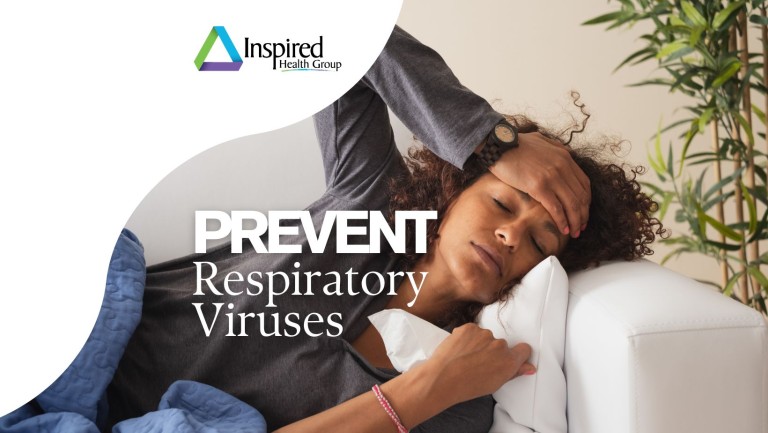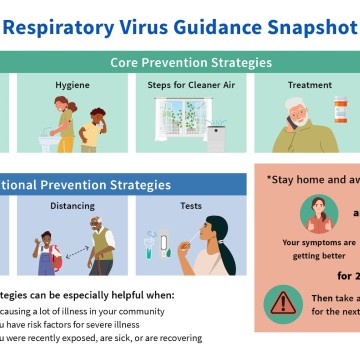Learn the updated guidance for respiratory viruses, including COVID-19, to help protect yourself and others from health risks caused by respiratory viruses.
Each year, respiratory viruses are responsible for millions of illnesses and thousands of hospitalizations and deaths in the United States. These respiratory viruses include those that cause COVID-19, flu and respiratory syncytial virus (RSV). The good news is there are actions you can take to help protect yourself and others from health risks caused by respiratory viruses.
Order your 4 free at-home COVID-19 tests
Respiratory Virus Guidance as of Oct 2024:
Core Strategies for Preventing Respiratory Viruses:
Immunizations for Respiratory Viruses
Stay up to date with the immunizations that are recommended for you.
- For most people that means getting a current flu and COVID-19 vaccine.
- Everyone ages 75 and older should get a respiratory syncytial virus (RSV) vaccine.
- CDC also recommends adults ages 60-74 who are at increased risk of severe RSV disease get an RSV vaccine.
- To prevent severe RSV disease in infants, CDC recommends either the pregnant mother gets an RSV vaccine, or the infant gets an immunization with an RSV monoclonal antibody. Most infants will not need both.
Practice good hygiene by covering your coughs and sneezes, washing your hands often, and cleaning frequently touched surfaces.
- Cover your mouth and nose with a tissue when you cough or sneeze. Throw used tissues in the trash. If you don't have a tissue, cough or sneeze into your elbow, not your hands.
- Learn and use proper handwashing technique.
- Teach children the correct way to wash their hands.
- Clean frequently touched surfaces, such as countertops, handrails, and doorknobs regularly.
Take steps for cleaner air. This can mean bringing in fresh outside air, purifying indoor air, or gathering outdoors. Virus particles do not build up in the air outdoors as much as they do indoors.
- Bring as much fresh air into your home as possible by opening doors and windows and/or using exhaust fans.
- If your home has a central heating, ventilation, and air conditioning system (HVAC, a system with air ducts that go throughout the home) that has a filter, set the fan to the "on" position instead of "auto" when you have visitors and use pleated filters. Change your filter every three months or according to the manufacturer's instructions.
- Use a portable high-efficiency particulate air (HEPA) cleaner.
- Move activities outdoors, where airflow is best.
Preventing Spread of Respiratory Viruses When You're Sick
Stay home and away from others (including people you live with who are not sick) if you have respiratory virus symptoms that aren't better explained by another cause. These symptoms can include fever, chills, fatigue, cough, runny nose, and headache, among others.
- You can go back to your normal activities when, for at least 24 hours, both are true:
- Your symptoms are getting better overall, and
- You have not had a fever (and are not using fever-reducing medication).
- When you go back to your normal activities, take added precaution over the next 5 days, such as taking additional steps for cleaner air, hygiene, masks, physical distancing, and/or testing when you will be around other people indoors. This is especially important to protect people with factors that increase their risk of severe illness from respiratory viruses.
- Keep in mind that you may still be able to spread the virus that made you sick, even if you are feeling better. You are likely to be less contagious at this time, depending on factors like how long you were sick or how sick you were.
- If you develop a fever or you start to feel worse after you have gone back to normal activities, stay home and away from others again until, for at least 24 hours, both are true: your symptoms are improving overall, and you have not had a fever (and are not using fever-reducing medication). Then take added precaution for the next 5 days.
- If you never had symptoms but tested positive for a respiratory virus:
- You may be contagious. For the next 5 days: take added precaution, such as taking additional steps for cleaner air, hygiene, masks, physical distancing, and/or testing when you will be around other people indoors. This is especially important to protect people with factors that increase their risk of severe illness from respiratory viruses.
Additional Strategies for Preventing Respiratory Viruses:
Mask Wearing for virus prevention
Wearing a mask can help lower the risk of respiratory virus transmission. When worn by a person with an infection, masks reduce the spread of the virus to others. Masks can also protect wearers from breathing in infectious particles from people around them.
- When choosing to wear a mask, choose the most protective type you can. Determine how well it fits. Gaps can let air leak in and out. Check for gaps by cupping your hands around the outside edges of the mask. If the mask has a good fit, you will feel warm air come through the front of the mask and may be able to see the mask material move in and out with each breath.
- Learn about proper technique for wearing an N95 respirator.
Putting physical distance between yourself and others can help lower the risk of spreading a respiratory virus. There is no single number that defines a “safe” distance, since spread of viruses can depend on many factors.
- Avoid being near someone who has respiratory virus symptoms.
- Avoid crowded areas where you may be unable to maintain physical distance.
Testing for Respiratory Viruses
Testing for respiratory viruses can help you decide what to do next, like getting treatment to reduce your risk of severe illness and taking steps to lower your chances of spreading a virus to others. There are various types of tests for respiratory virus infections. Antigen tests (“self-tests” or “rapid tests”) usually return results quickly (around 15 minutes). Nucleic acid amplification tests (NAATs), which include polymerase chain reaction (PCR) tests, are normally conducted by a healthcare provider. Although antigen tests are usually faster, they are not as good at detecting viruses as NAATs. This means that you might get a negative result with an antigen test, but actually be infected with the virus.
- Plan in advance of any illness so you can be ready to get tested quickly, particularly if you are someone who could benefit from treatment for respiratory viruses.
- Antigen tests can be used for screening before gathering with others, especially to help protect people in your life who have risk factors for severe illness. However, false negatives are possible; false positives are uncommon.
- Order Your 4 Free At-home COVID-19 Tests
Key Times for prevention:
- Respiratory viruses are causing a lot of illness in your community.
- You or the people around you were recently exposed to a respiratory virus, are sick, or are recovering.
- You or the people around you have risk factors for severe illness.
- Many factors can make it more likely for someone to become very sick from a respiratory virus. In addition to this guidance, there are several specific considerations for people with certain risk factors for severe illness (young children, older adults, people with weakened immune systems, people who are pregnant, and people with disabilities).
- You may not be aware of the things that can make others more vulnerable to serious illness. Using the core prevention strategies will provide a degree of protection regardless. If you are unsure about the health condition or risk status of those around you, the most protective option is choosing to use additional prevention strategies, like masking, physical distancing, and testing.
Learn more about the guidance from the Center from Disease Control and Prevention as of October 2024
Related Blogs:
Flu Vaccine Clinics at Inspired Health Group


